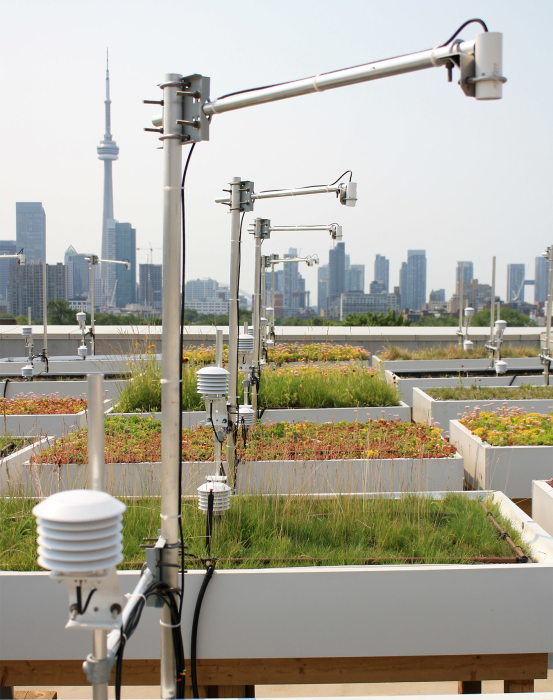


問題 — 緑の屋根の性能を最適化する方法
トロント大学のグリーン ルーフ イノベーション テスト ラボ (GRIT ラボ) は、断熱、降雨吸収、美観と環境面での利点を提供する植物床で覆われた屋根であるグリーン ルーフの性能を調査し、最適化するために設立されました。GRIT ラボは、気象観測所と 1.22 m x 2.44 m (4 フィート x 8 フィート) の 33 個の盛り土床で構成されるサイトで、さまざまな土壌媒体、土壌量、植物の種類、灌漑方式を使用して、継続的な実験を行っています。目標は、南オンタリオのグリーン ルーフに関する 4 つの主な変数を評価することです。
- 雨水管理
- 蒸発冷却
- 生物多様性
- ライフサイクルコスト
ソリューション - 33のテストベッドからのデータ収集
このアプリケーションでは、1 台の CR3000 データロガーと 2 台の CR1000 データロガー、および複数の AM16/32B マルチプレクサを使用して、次の 4 つのパラメータを比較するために使用される約 300 個のセンサーを測定します。
- 栽培用培地の種類(FLL標準と高有機含有量)
- 栽培用培地の深さ(4 インチ vs. 6 インチ)
- 植生群落(セダム対在来種および生物多様性に富む草原と牧草地の混合)
- 灌漑方式(なし、タイマー作動、土壌水分センサー作動)
各ベッドには、土壌媒体の内外のさまざまな深さと土壌上のさまざまな高さに設置された複数の温度センサーが装備されています。これらの機器は、さまざまな土壌媒体を通る熱流を測定します。赤外線放射計は、植生の平均温度も測定します。
雨水管理と灌漑体制も調査されており、各高床の下に設置された大容量の転倒マスを使用して、さまざまな土壌媒体からの流出量を調べています。土壌水分センサーは、土壌が保持する水分量を追跡します。気象ステーションは、一般的な気象条件と降雨量を測定し、加圧灌漑システムに設置された流量計は、各高床に入る水の量を概算して流出量を決定します。さまざまな灌漑体制、土壌媒体、植物の種類は、特に嵐や散水の間に、流出量と水分保持量に大きな影響を与えるはずです。